![]()
![]()
![]()
Use LEFT and RIGHT arrow keys to navigate between flashcards;
Use UP and DOWN arrow keys to flip the card;
H to show hint;
A reads text to speech;
80 Cards in this Set
- Front
- Back
- 3rd side (hint)
|
List the Types of GLIAL cells |
•Schwann Cells (PNS), •Oligodendrocytes (CNS) •Astrocytes (CNS) •Microglia (CNS) •Ependymal cells (CNS) |
|
|
|
Schwann cells Function |
Form myelin & increase speed of conduction of Action Potentials along axon |
|
|
|
Oligodendrocytes Function |
Form myelin & increase speed of conduction of Action Potentials along axon |
|
|
|
Astrocytes Function |
•Guide neuronal development •Regulate synaptic communication via regulation of neurotransmitter levels |
|
|
|
Microglia Function |
Remove dead cells and debris |
|
|
|
Ependymal cells Function |
Produce and circulate cerebrospinal fluid |
|
|
|
Name different types of Neurotransmitters |
•Acetylcholine •GABA (gamma-aminobutyric acid) •Serotonin •Dopamine •norepinephrine |
|
|
|
When is a neurotransmitter termed EXCITATORY |
When it opens a channel that depolarizes the postsynaptic membrane. (Basically It induce depolarization of the postsynaptic membrane) |
|
|
|
When is a neurotransmitter termed INHIBITORY |
When it opens a channel that hyperpolarize the postsynaptic membrane (so it basically induce hyperpolarization of the postsynaptic membrane) |
|
|
|
Can neurotransmitters be both EXCITATORY & INHIBITORY ? |
YES! Postsynaptic neurons may have many different receptors, allowing them to respond to many different neurotransmitters. So the same neurotransmitter can be excitatory in some cases & inhibitory in others |
|
|
|
Motor neurons are also known as ? |
Efferent neurons |
|
|
|
Sensory neurons are also known as ? |
Afferent Neurons |
|
|
|
Define Efferent Neurons |
They are neurons that carry information AWAY from the CNS and innervate effectors (organs). *Remember: efferents go to effectors) |
Efferents go to effectors |
|
|
Define Afferent Neurons |
They carry information TOWARD the central nervous system |
|
|
|
What are the 3 subdivisions of the brain? |
•Prosencephalon (Forebrain) •Mesencephalon (Midbrain) •Rhombencephalon (Hindbrain) |
|
|
|
Hindbrain includes what? & what are their functions? |
•Includes: Medulla, Pons, Cerebellum [Functions] ●MEDULLA- Relays information between other areas of the brain & regulates autonomic functions such as blood pressure & digestive functions including vomiting. Respiratory rhythmicity centers are found here ●PONS- deal primarily with sleep, respiration, swallowing, bladder control, hearing, equilibrium, taste, eye movement, facial expressions, facial sensation, and antigravity posture. ●CEREBELLUM- Regulates motor movements. Coordinates voluntary movements such as posture, balance, coordination, and speech, resulting in smooth and balanced muscular activity. |
|
|
|
Functions of the Midbrain: |
Midbrain is a relay for visual & auditory information & and contains much of the reticular activating system (RAS) which is responsible for arousal or wakefulness |
|
|
|
Forebrain includes what 2 parts? & what does each part constitute along with their functions? |
● 2 parts is: Diencephalon & Telencephalon. [Diencephalon constitutes:] ●Thalamus- the large mass of gray matter in the dorsal part of the diencephalon of the brain with several functions such as relaying of sensory and motor signals to the cerebral cortex, and the regulation of consciousness, sleep, and alertness. ●Hypothalamus- controls emotion & has a role in hormone production & release. Also linked to endocrine systems by controlling the pituitary gland. [Telencephalon constitutes:] ●Has 2 cerebral hemispheres left & right. Left hemisphere control motor functions & is generally responsible for speech. Right hemisphere responsible for visual-spatial reasoning & music. |
|
|
|
4 parts of the cerebral cortex & functions |
●Frontal Lobes- initiate all voluntary movement & involved in complex reasoning skills & problem solving. ●Parietal Lobes- involved in general sensations (touch, temperature, pressure, vibration) & gustation (taste) ●Temporal Lobes- process auditory & olfactory sensation sensation & are involved in short-term memory, language comprehension & emotion ●Occipital Lobes- Process visual sensation |
|
|
|
Vagus Nerve |
The 10th cranial nerve (X), effects of this nerve is to decrease heart rate & increase GI activity |
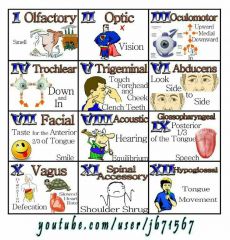
|
|
|
Define: Exteroceptors |
Sensory receptors that detect stimuli from the outside world |
|
|
|
Define: Interoceptors |
Receptors that respond to internal stimuli |
|
|
|
List the 5 Types of sensory receptors: |
●Mechanoreceptors ●Chemoreceptors ●Nociceptors ●Thermoreceptors ●Electromagnetic receptors |
|
|
|
What are : Mechanoreceptors ? |
Receptors that respond to mechanical disturbances. For Ex. *Pacinian Corpuscles* which are pressure sensors deep in the skin, that get distorted by firm pressure on the skin. Ex #2 auditory hair cell found in the cochlea of the inner ear that detects vibrations caused by sound waves. Ex #3 Vestibular hair cells located within semicircular canals in the inner ear, they detect acceleration and position relative to gravity. |
|
|
|
What are : Chemoreceptors? |
Receptors that respond to particular chemicals. Ex. Olfactory receptors detect airborne chemicals & allow us to smell things. Ex #2 taste buds are gustatory receptors |
|
|
|
What are : Nociceptors ? |
Pain receptors that are stimulated by tissue injury/damage. They give a sensation of dull, aching pain. May also create the illusion of pain on the skin, a phenomenon known as Referred Pain. |
|
|
|
What are : Thermoreceptors ? |
Receptors stimulated by changes in temperature |
|
|
|
What are : Electromagnetic receptors ? |
Receptors stimulated by electromagnetic waves. Only example in humans are the rod and cone cells of the retina of the eye (also called photoreceptors). |
|
|
|
Define : Adaptation |
Adaptation is a decrease in firing frequency when the intensity of a stimulus remains constant. Ex. You walk in a room where bread is baking, the bread odor molecules stimulate your olfactory receptors & you smell the bread baking. But if you remain in the room you will stop smelling the bread |
|
|
|
What is : Proprioceptors |
Refers to awareness of self. Allows us to know the positions of our body parts |
|
|
|
What is GUSTATION ? |
Senses of taste on our taste buds |
|
|
|
What is OLFACTION ? |
Sense of smell |
|
|
|
Define: Pheromones |
Chemical signals that cause a social reponse in members of the same species. |
|
|
|
Summary: From Sound to Hearing (THE STEPS) |
sound waves > auricle > external auditory canal > tympanic membrane > malleus > incus > stapes > oval window > perilymph > endolymph > basilar membrane > auditory hair cells > tectorial membrane > neurotransmitters stimulate bipolar auditory neurons > brain > perception |
|
|
|
Pitch is referred to as what? |
Frequency of sound |
|
|
|
Loudness is referred to as what? |
Amplitude of vibration |
|
|
|
Emmetropia |
Term for Normal Vision |
|
|
|
Myopia (nearsightedness) |
Where there is too much curvature causing light to be bent too much and to be focused in front of the retina. Can be corrected by a concave diverging lens, which will cause the light rays to diverge slightly before they reach the cornea |
|
|
|
Hyperopia (farsightedness) |
Results from the focusing of light behind the retina. Can be corrected by a convex converging lens, which will cause light rays to converge before reaching the cornea |
|
|
|
Presbyopia |
It's an inability to accomadate focus. It results from loss of flexibility of the lens, which occurs with aging. |
|
|
|
Bottom-up Processing |
Where information enters the eyes in one direction & is then turned into an identifiable image by the brain. |
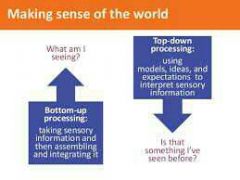
|
|
|
Top-down processing |
Occurs when the brain applies experience & expectations to interpret sensory information |
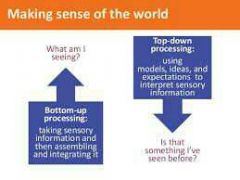
|
|
|
Hormones of the posterior pituitary are |
ADH (antidiuretic hormone) or Vasopressin, which causes the kidney to retain water during times of thirst & oxytocin which causes milk let-down for nursing as well as uterine contractions during labor |
|
|
|
Hypothalamus is the portion of the brain that controls much of what system? |
The Endocrine system |
|
|
|
The Hypothalamus is involved with what types of hormones? Peptides or steroids? |
Peptide hormones. & it functions by controlling releasing & inhibiting factors to the anterior pituitary. |
|
|
|
Anterior Pituitary releases what 6 hormones that target what? |
●GH*Growth Hormone (peptide)- Increase bone & muscle growth & increase cell turnover rate ●Prolactin (peptide)- mammary gland/milk production ●TSH*Thyroid Stimulating Hormone(peptide) (Tropic)-Thyroid increases synthesis & release of TH ●ACTH*Adrenocorticotrolic Hormone (peptide- increases growth & secretory activity of adrenal ctx. ●LH* Luteinizing Hormone (peptide) (gonadotropic)- Ovary/ovulation, testes/testosterone synth. ●FSH* Follicle stimulating hormone (peptide) -Ovary/follicle development, testes/spermatogenesis |
|
|
|
Posterior Pituitary releases what list of hormones that target what? |
●ADH* Antidiuretic Hormone, Vasopressin (peptide)- kidney/water retention ●Oxytocin (peptide)- Breast/milk letdown, uterus/contraction |
|
|
|
Thyroid releases what list of hormones that target what? |
●TH*Thyroid Hormone & Thyroxine- Child: necessary for physical & mental development; Adult: increases metabolic rate & temp. ●Calcitonin (peptide released by thyroid C cells)- bone, kidney; lowers serum [Ca2+] |
|
|
|
Parathyroids release what hormone? |
Parathyroid hormone (PTH) (peptide)- bone, kidney, small intestine/raises serum [Ca2+] |
|
|
|
Adrenal Medulla release what hormone? |
Epinephrine- sympathetic stress response (rapid) |
|
|
|
Adrenal Cortex release what hormone? |
●Cortisol (glucocorticoid) (steroid)- longer-term stress response; increase blood glucose; increase protein catabolism; decrease inflammation & immunity ●Aldosterone (mineralocorticoid) (steroid)- Kidney/ increase Na+ reabsorption to increase b.p. ●Sex steroids |
|
|
|
Endocrine organ: Pancreas (islets of Langerhans) release what hormones? |
●Insulin (secreted by Beta cells) (peptide) absent or ineffective in diabetes mellitus- Decrease blood [glucose]/ increase glycogen & fat storage ●Glucagon- (secreted by alpha cells) (peptide)- Increase blood [glucose]/ Decrease glycogen & fat storage ●Somatostatin (peptide)- inhibits the pituitary gland's secretion of growth hormone and thyroid stimulating hormone; inhibits the secretion of other pancreatic hormones such as insulin and glucagon |
|
|
|
Testes release what hormone? |
Testosterone (steroid)- male characteristics, spermatogenesis |
|
|
|
Ovaries/placenta release what hormone? |
●Estrogen (steroid)- female characteristics, endometrial growth ●Progesterone (Steroid)- endometrial secretion, pregnancy |
|
|
|
What is the cocktail party effect? |
Cocktail party effect happens when information of personal importance from previously unattended channels catches our attention. Ex. imagine you are in a conversation w/ someone at a party in a room full people. You are not aware of the content of other conversations until suddenly you hear the name of your best friend mentioned in a conversation behind you. |
|
|
|
Jean Piaget believed what about cognitive development? |
That we either assimilate our experiences by confirming them into our existing schemas OR we accomadate by adjusting our schemas to take into account the new experience. Ex. If a young girl believes there is a monster under the bed but her parents turn on the light to reveal that there isn't, the girl can either ASSIMILATE this experience by believing that the monster still exist & it's just running away from the light OR she can ACCOMADATE her schema by agreeing that there must be no monster. |
|
|
|
Piaget's 4 stages of development are? |
1) Sensorimotor Stage: Birth to 2 yrs, babies & young infants experience the world through their senses & movement, such as looking, touching, mouthing & grasping. They learn about OBJECT PERMANENCE- the understanding that things continue to exist when they are out of sight. They also have stranger anxiety, distress when confronted with an unfamiliar person. 2) Preoperational Stage- Ages 2-7 during this time, children learn that things can be represented through symbols like words & images. This accompanies their learning during pretend play & development of language. They still lack logical reasoning & are also egocentric- meaning they do not understand that others have different perspectives. 3.) Concrete Operational Stage- 7-11 yrs, children learn to think logically about concrete events. It helps them learn about the principal of conservation: the idea that quantity remains the same despite changes in shape. Ex. If water from a wide bowl is poured into a thin cylinder, it still has the same volume despite diff in height. They also grasp math concepts during this time. 4.) Formal Operational Stage: 12-adulthood, when people learn absrract reasoning (e.g. hylothesizing) & moral reasoning |
|
|
|
Define RECALL |
Involves retrieving information from memory without any clues. Ex. Asking an eye witness to describe the face of a suspect |
|
|
|
Define Recognition |
Involves retrieving information from memory with clues. Ex. Asking an eye witness to identify a suspect out of a lineup |
|
|
|
Define Confirmation Bias |
A tendency to search only for information that confirms our preconceived thinking, rather than information that might not support it. You are NOT approaching a problem from multiple perspectives, you are only viewing it from one way/your way. Ex. You are in charge of staffing nurses at an ER & you believe that there are more admissions on college footbal night's than other days. You will tend to take notice of admissions during football nights, but less inattentive to admissions during other night's in the month. Over time this will unjustifiably strengthen your belief & lead to poor staffing decisions. |
|
|
|
Define Fixation |
Your unable to see the problem from a fresh perspective. A tendency to fixate on solutions that worked in the past though they may not apply to the current situation. Ex. A parent trying to discipline a child may not realize that time-outs at age 15 are just not effective as they were at age 5. |
|
|
|
Define Functional Fixedness |
A tendency to perceive the functions of objects as fixed & unchanging. Ex. A person may decide to search everywhere for a box-cutter to open a package, when a readily available key would work just as well |
|
|
|
Alertness & Arousal are controlled by what? |
Structures within the brain stem known as Reticular Formation AKA Reticular Activating System (RAS) |
|
|
|
The 4 STAGES OF SLEEP & REM? |
●Alpha & Beta waves LOW AMPLITUDES & HIGH FREQUENCIES on the EEG are the first indicator that a person is ready to drift off to sleep, the body relaxes & you feel drowsy. ●When sleep begins, the first stage of non-REM (Rapid Eye Movement) sleep is entered. This is stage 1 sleep & the EEG is dominated by theta waves LOW TO MODERATE INTENSITY & INTERMEDIATE FREQUENCY; slow rolling eye movements & less responsive to stimuli ●Stage 2: There is no eye movement & EMG measured moderate activity. This stage brings increased relaxation such as decreased heart rate, respiration & temperature. 2 distinct wave patterns show on the EEG which are K-complexes (large & slow waves) & Sleep spindles (burst of waves) ●Stage 3: person transitions into slow wave sleep. Stage 3 & 4 are characterized by Delta Waves, High in amplitude & low frequency waves. This is the deepest level of sleep. Person continues to show no eye movement & moderate muscle movement. Heart rate & digestion are slow & growth hormones are secreted. ●*STAGE 4* REM Sleep aka "paradoxical sleep": characterized by bursts of quick eye movements. Has low almost no skeletal muscle movement. Waves are similar to Beta Waves seen in ppl when awake. The person physiologically appears to be awake but their muscle movement does not corroborate, the person is nearly paralyzed except for sudden bursts or twitches. REM slepp is generally when dreams occur. |
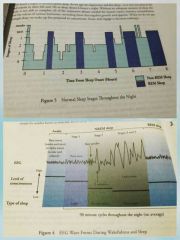
|
|
|
Difference between Dyssomnias & Parasomnias? |
●Dyssomnias: Are abnormalities in the amount, quality, or timing of sleep & include insomnia, narcolepsy & sleep apnea ●Parasomnias: Are abnormal behaviors that occur during sleep & include somnambulism (sleep walking) & night terrors. |
|
|
|
Dissociation theory |
Suggests that hypnotism is an extreme form of divided consciousness |
|
|
|
Social influence theory |
Suggests that people do and report what's expected of them. The person's emotions, opinions, or behaviors are affected by others. |
|
|
|
3 main types of psychoactive drugs |
●Depressants ●Stimulants ●hallucinogenics |
|
|
|
Depressants: |
Include alcohol, barbiturates (Tranquilizers or sleep aides) and opiates (morphine & heroin). They work by depressing or slowing down neural activity. |
|
|
|
Stimulants: |
Include caffeine, nicotine, cocaine & amphetamines. They work by either increasing the release of neurotransmitter, reducing the reuptake of neurotransmitter, or both. Their overall effect is to speed up body functions, resulting in increased energy, respiratory rate, heart rate & pupil dilation. PPL use stimulants to stay awake, enhance physical performance and boost mood |
|
|
|
Hallucinogens: |
Distort perceptions in the abscence of any sensory input, creating hallucinations. These include LSD & MARIJUANA. |
|
|
|
Darwin 6 major universal emotions: |
●Happiness ●Sadness ●Surprise ●Fear ●Disgust ●Anger |
|
|
|
James-Lange Theory of EMOTION: |
Proposes that first we experience the physiological response & then we expeeience the emotion. In other words, Instead of feeling an emotion and subsequent physiological (bodily) response, the theory proposes that the physiological change is primary, and emotion is then experienced when the brain reacts to the information received via the body's nervous system. Ex. Of a scary dog chases you, first you experience an increase heart rate & this is followed by the conscious labeling of the experience as fear. It implies that YOU FEEL AFRAID BECAUSE YOUR HEART IS RACING. |
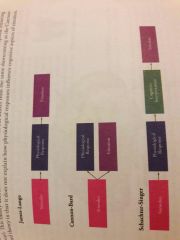
|
|
|
Canon-Bard theory of Emotion |
Suggest that after a stimulus, the physiological response & the experience of emotion occur simultaneously & independently of eachother. Ex. A scary dog comes running after you (stimulus) & you then experience fear (emotion) & an increased heart rate (physiological response) at the same time; |
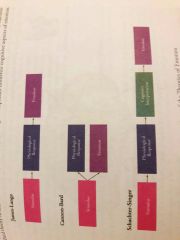
|
|
|
Schacter-singer theory of EMOTION A.K.A the Two-Factor theory of emotion |
Says once we experience physiological arousal, we name a conscious cognitive interpretation based on our circumstances, which allows us to identify the emotion we are experiencing. |

|
|
|
Broca's area: |
Located in LEFT hemisphere of the frontal lobe in the brain, is involved in the process of speech production. Injury to this area will lead to Broca's Aphasia- when you lose the ability to speak. People with Broca's Aphasia know what they want to say, but are unable to communicate it. They can comprehend words & simple sentences but are unable to generate fluent speech. |
|
|
|
Wernicke's Area: |
Located in the posterior part of the frontal lobe in the dominant hemisphere (the left), is involved in the comprehension of speech & written language. In people with injury to the Wernicke's area known as Wernicke's Aphasia, speech production retains a natural sounding rhythm & syntax BUT is completely meaningless. So people with Wernicke's Aphasia do not have a problem producing speech, but are incapable of producing intelligible, meaningful language. |
|
|
|
Baddeley's information processing model: |

|
|
|
|
Out of the 20 amino acids, Which is the SMALLEST & the ONLY Chiral? |
Glycine |
|
|
|
Which is the only amino acid that can form covalent bonds? |
Cystein |
|

